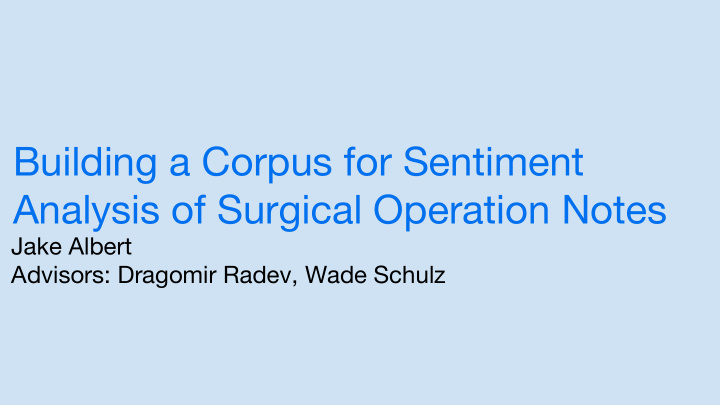



Building a Corpus for Sentiment Analysis of Surgical Operation Notes Jake Albert Advisors: Dragomir Radev, Wade Schulz
First, the PDA was exposed, and the right coronary artery was found to have moderate calcification throughout its course to the terminal bifurcation. Arteriotomy was performed on the PDA, which tolerated placement of a 1.5 French probe. We first constructed an anastomosis of the end of the reversed saphenous vein with 7-0 prolene. Next a 5 mm arteriotomy punch was used to expand a small stab incision in the ascending aorta, and an anastomosis was created between the saphenous vein and the ascending aorta with 7-0 prolene sutures. Next, we exposed the LAD, and arteriotomy of the vessel was performed. An end of the internal mammary was approximated to the arteriotomy and a side-to-side anastomosis was performed using 8-0 running proline. The internal mammary was tacked to the epicardium using its pedicle. The patient was given a dose of retrograde followed by anterograde cardioplegia, and de-airing was performed. The aortic cross-clamp was removed, and the heart was noted to resume spontaneous coordinated contractions. Temporary pacing wires were placed, followed by placement of Blake drains in the medial section. Two chest tubes were placed in the mediastinum, with two other tubes placed in the bilateral pleural cavities. V-pacing wires were also placed, and the patient was weaned off cardiopulmonary bypass without complication. All hemodynamic monitors, including intraoperative TEE, baseline EKG, and pulmonary monitoring were found to be normal. The pericardium and pericardial fat were loosely approximated, and the sternotomy was closed using steel wires. Next 0 vicryl sutures were used to reapproximate the musculofascial layer, and 4-0 Monocryl with skin glue were used to reapproximate the skin. Dressings were applied, and the patient was transferred to the CTICU on multiple drips of epinephrine, neosynephrine, and vasopressin. In the CTICU the patient was placed on APRV and overall in critical condition. All counts were correct at the end of the procedure. Bypass time was 120 minutes. All counts were correct at the end of the case.
Two Large Issues Objectivity/Subjectivity Sentiment Lexicon/Treebank
Plan: A Corpus of Annotated Operation Notes Two Domain-Specific Sentiment Categories: ● Complicated/Not Complicated ● Concerning/Not Concerning
COMPLICATED: COMPLICATED: NO YES “All hemodynamic monitors, “First, the PDA was exposed, including intraoperative TEE, and the right coronary artery CONCERNING: baseline EKG, and pulmonary was found to have moderate monitoring were found to be calcification throughout its NO normal.” course to the terminal bifurcation.” “Dressings were applied, and “The aortic cross-clamp was the patient was transferred to removed, however the heart CONCERNING: the CTICU on multiple drips of was not noted to resume epinephrine, neosynephrine, spontaneous coordinated YES and vasopressin for contractions.” hypotension.”
Training Scheme on Sentences ● Naive Bayes Classifier as baseline result ● RNN (word embeddings learned from corpus) ● RNN (word embeddings from BioNLP)
BioNLP vectors
Important Lesson: Getting enough labeled data takes TIME
Three Tasks for the Future: Labeled words → create a sentiment lexicon Labeled sentences → improve the classifier Labeled notes → find a function for overall sentiment
Recommend
More recommend